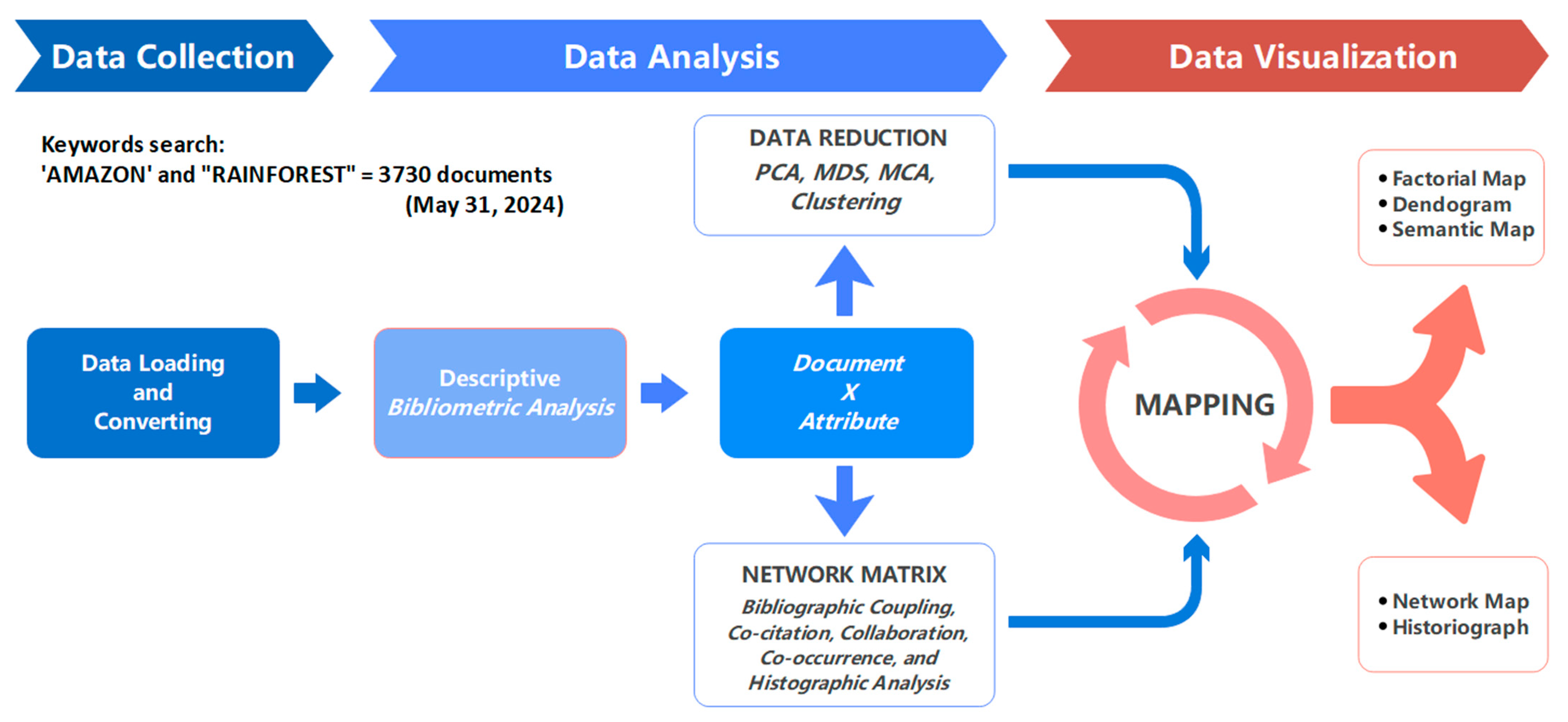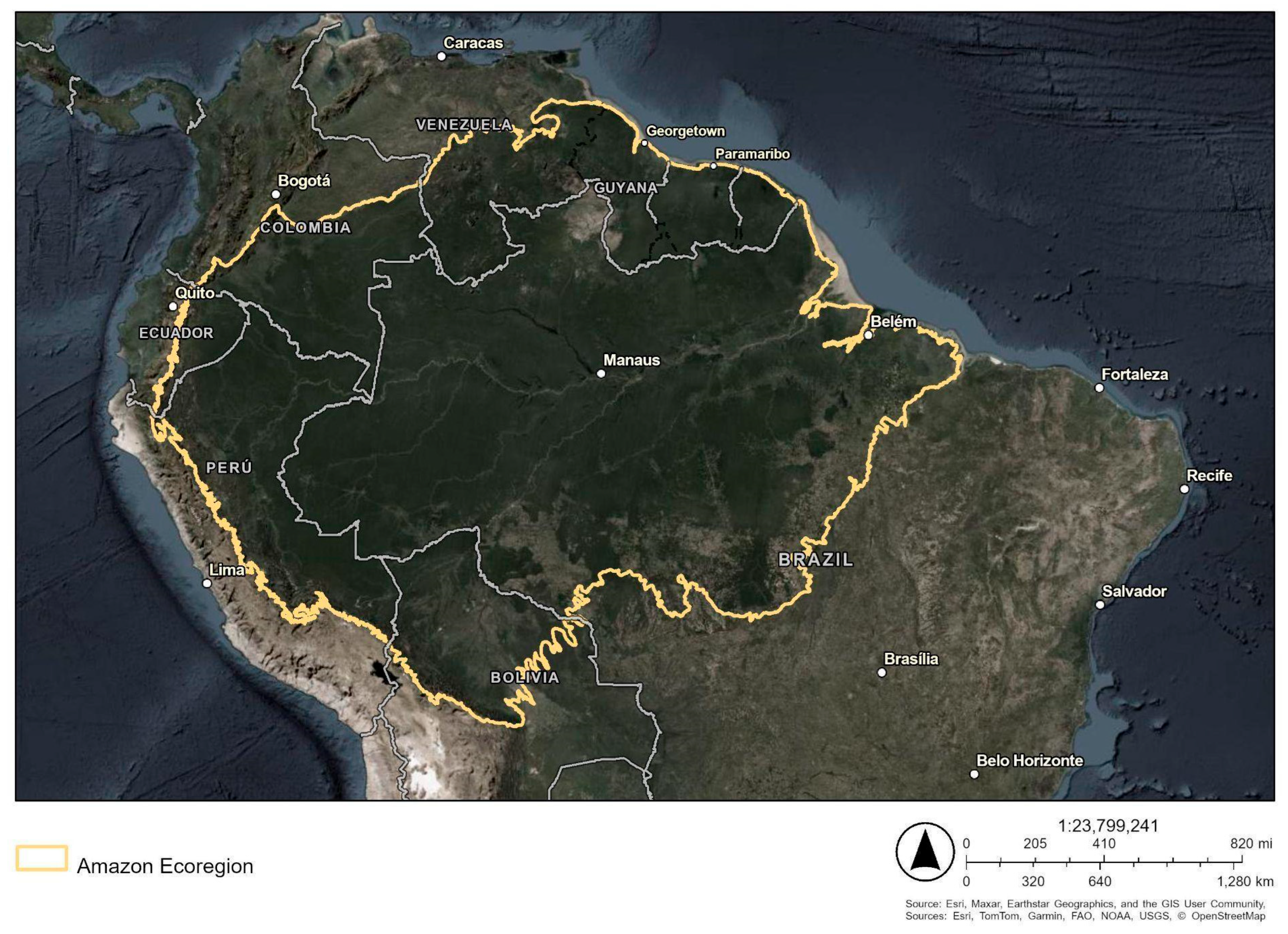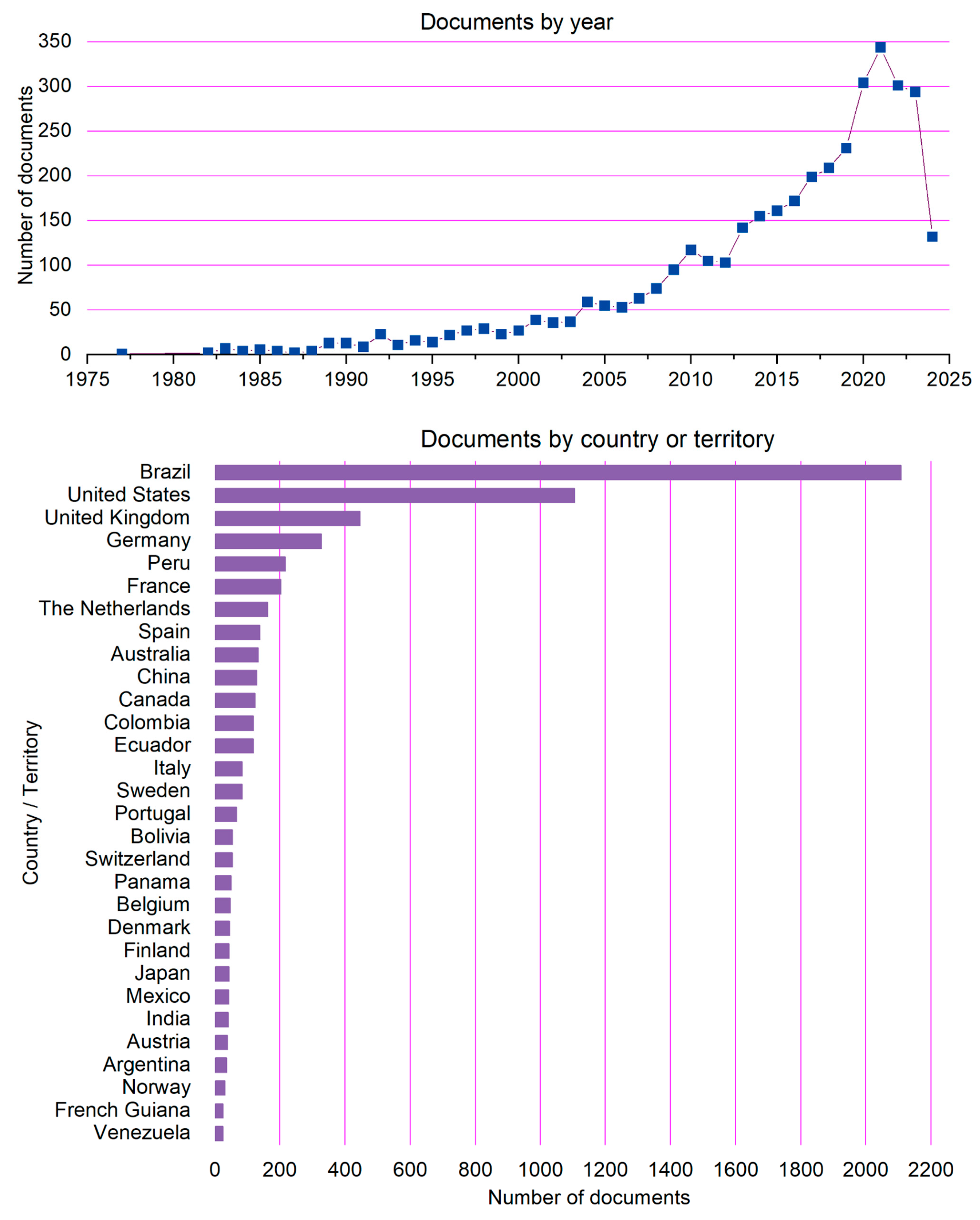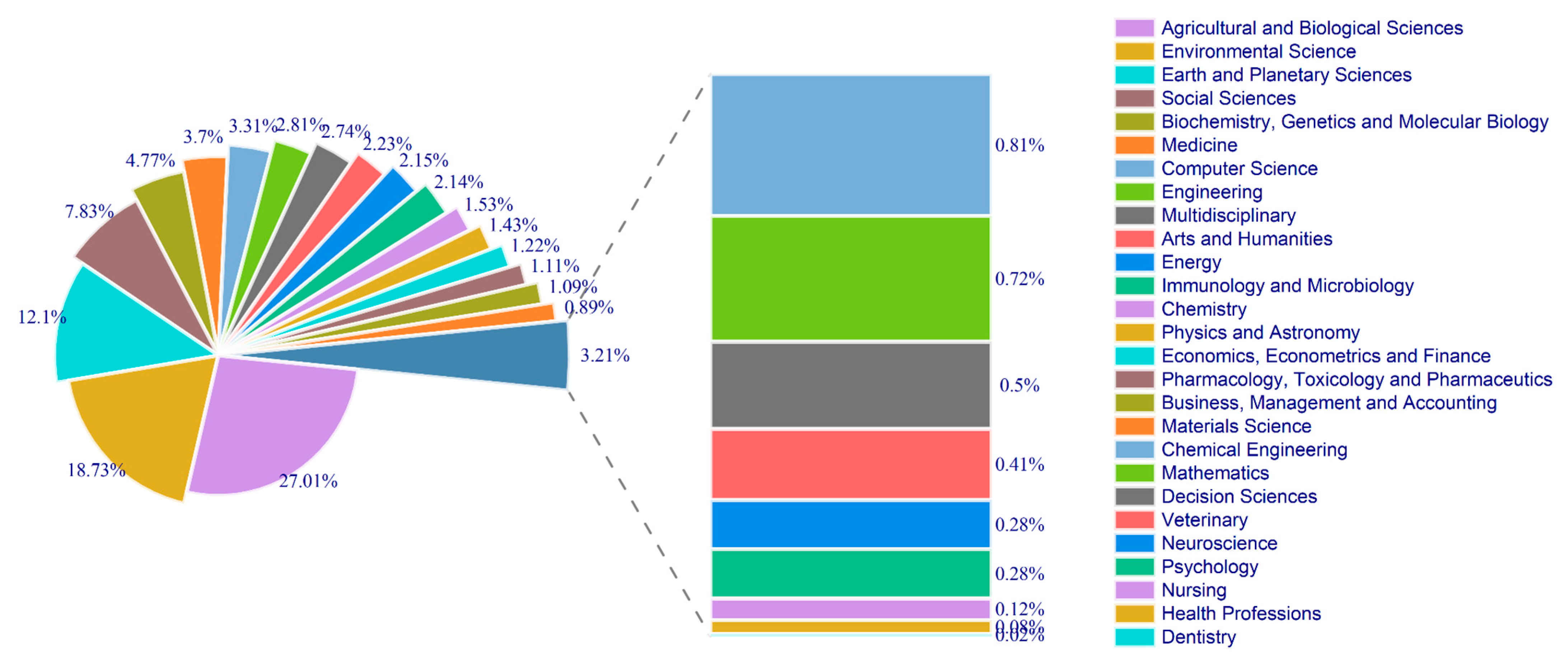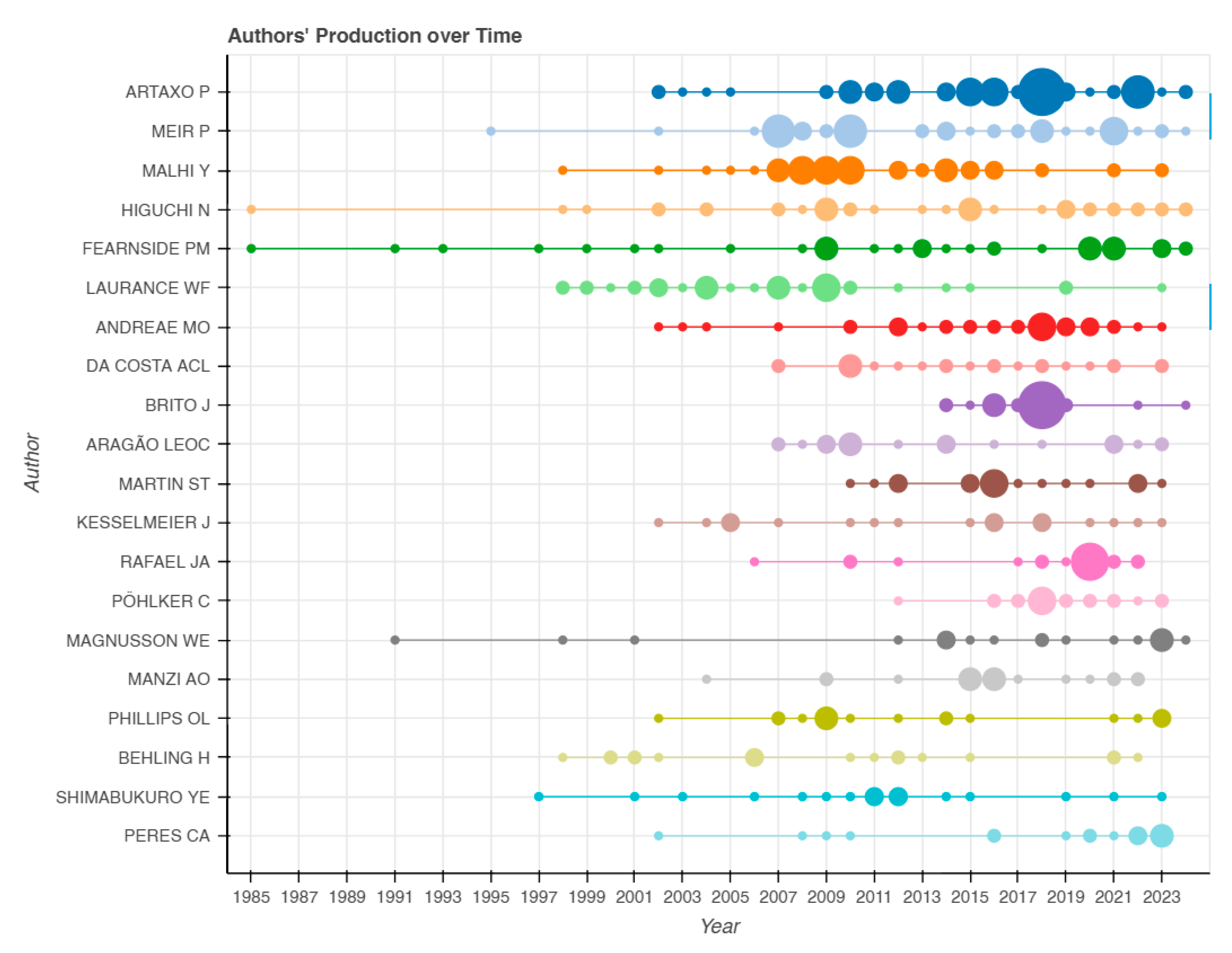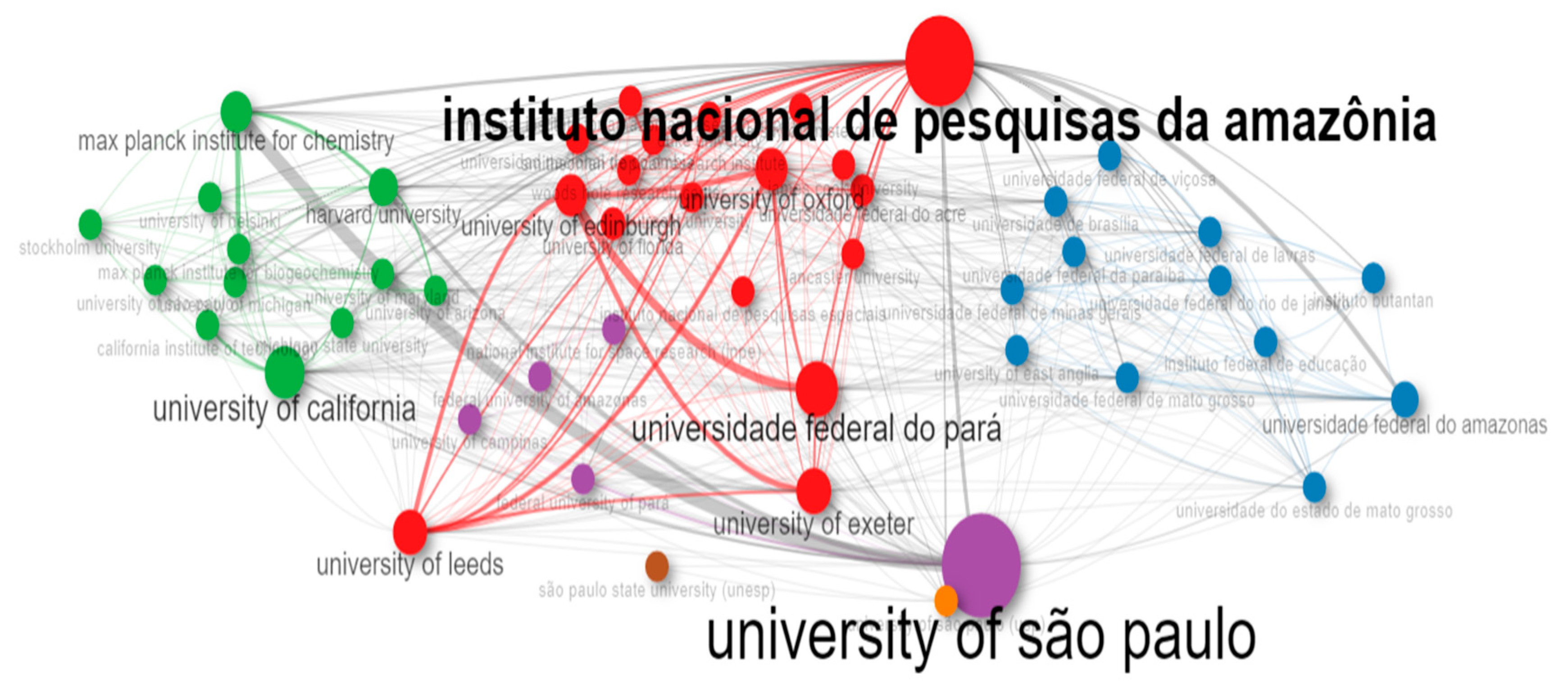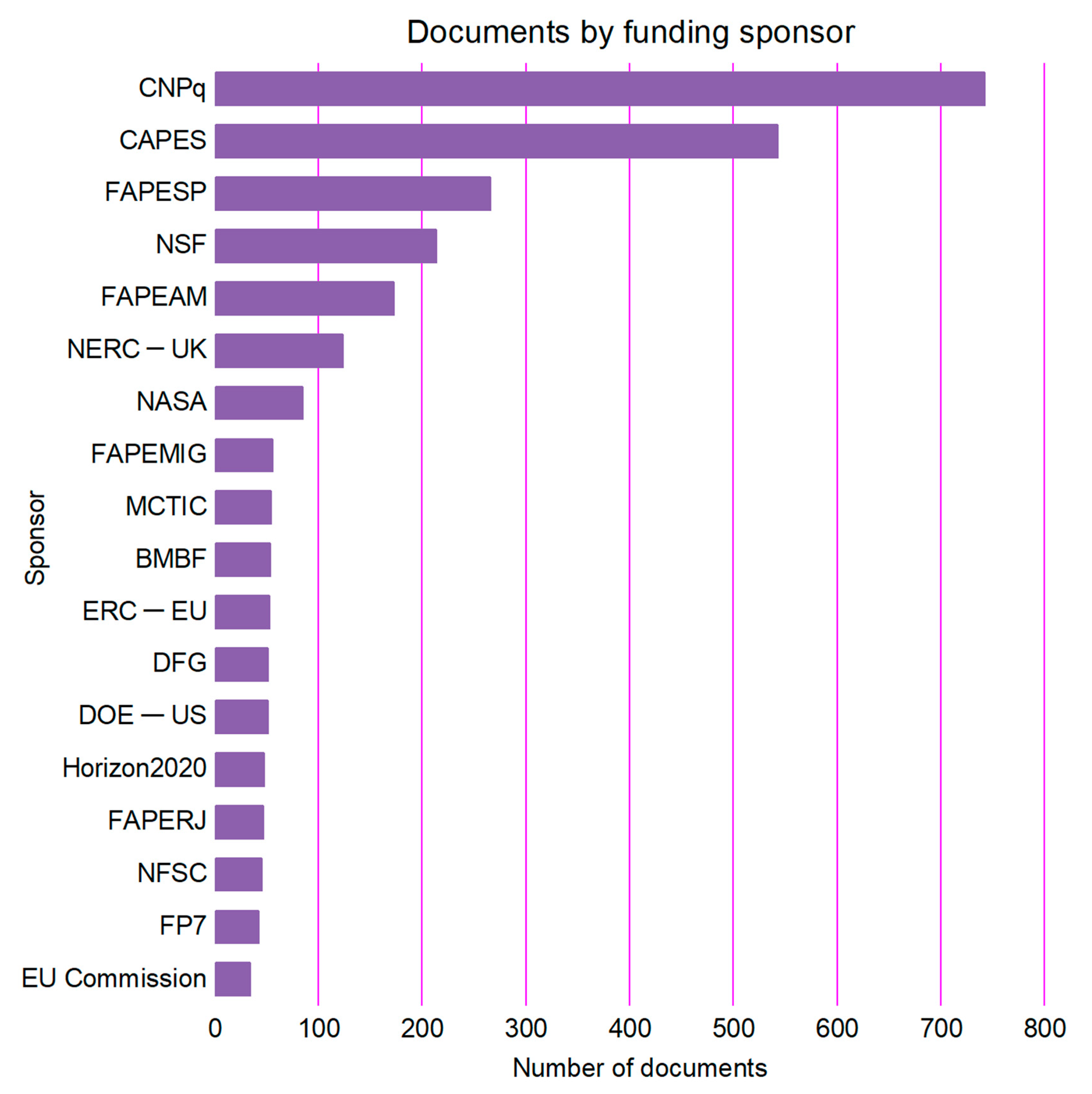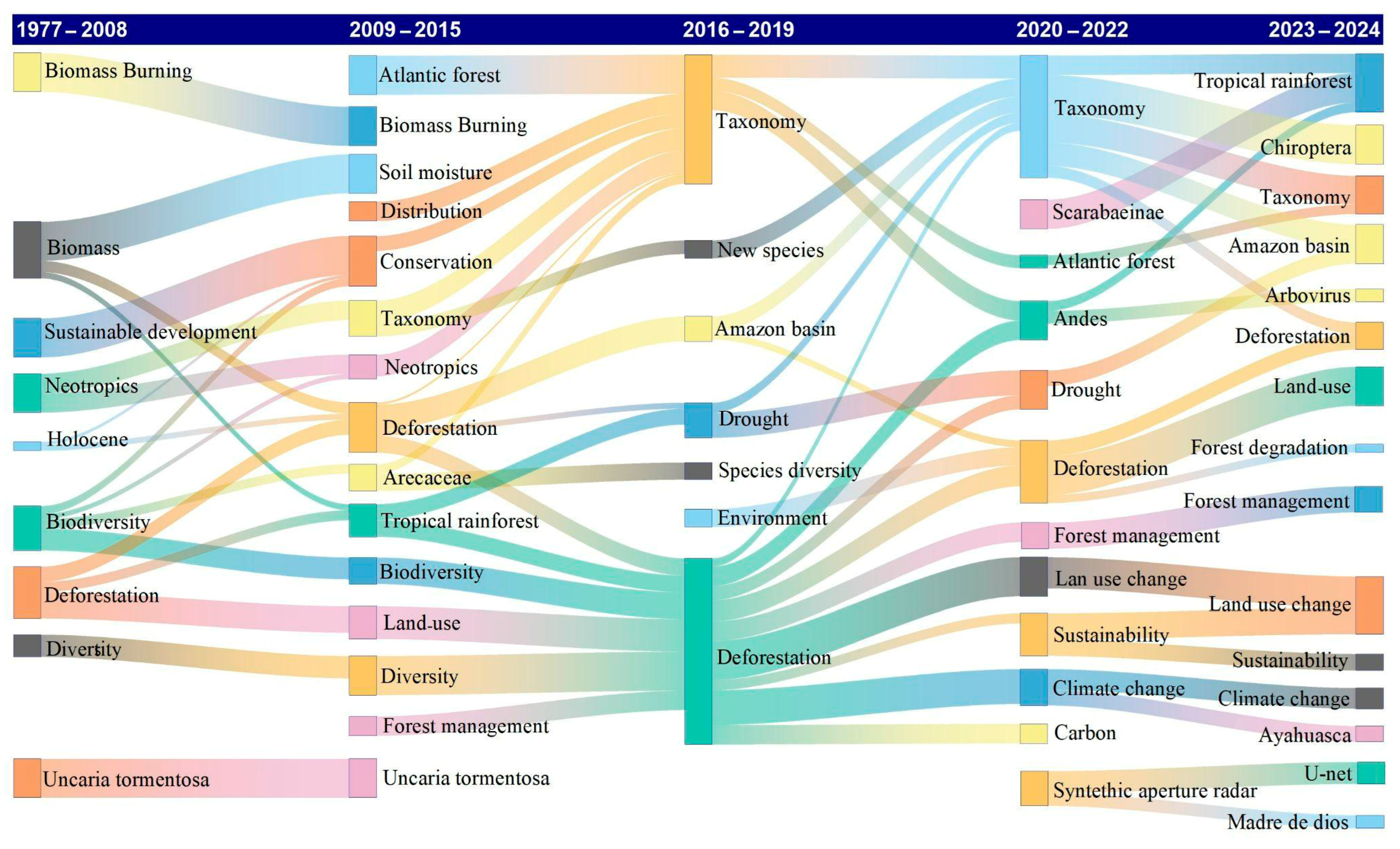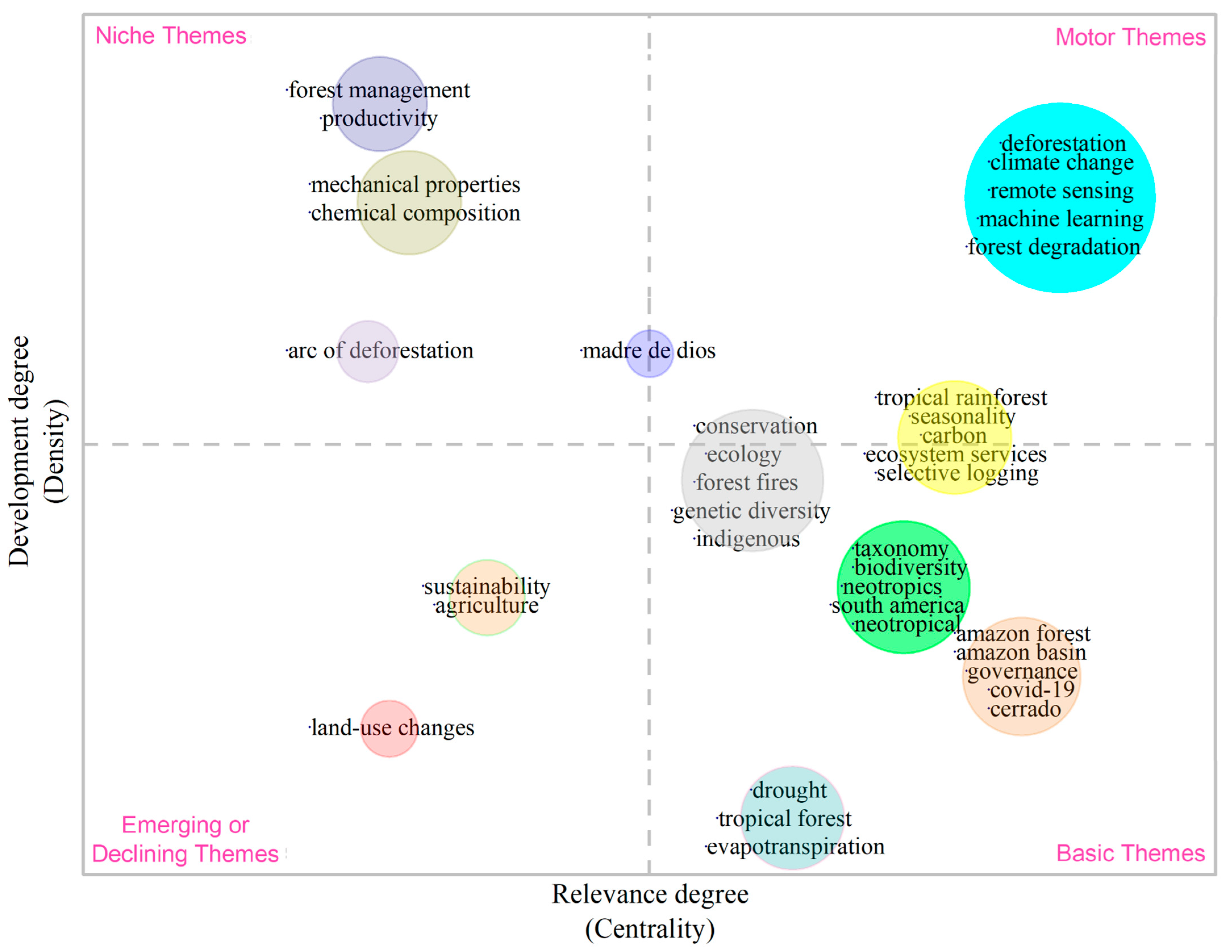3.1. The Advancement of Research: An Overview of Scientific Studies on the Amazon
It is crucial to understand the impacts of human activities and guide conservation and restoration efforts in the Amazon rainforest [
2]. The forest’s role as an essential agent in regulating the global climate, along with its remarkable biodiversity, has increasingly attracted the attention of both researchers and funders. Growing global awareness of the Amazon’s critical role in maintaining the planet’s health has significantly boosted international scientific research. The data presented in
Figure 4 illustrate the annual trends in scientific production over approximately 47 years (1977 to May 2024). Since the 2000s, scientific publications on the Amazon have expanded in both disciplinary scope and coverage, in response to growing global concern over deforestation and fires that have attracted international attention. Deforestation saw a resurgence in the early 2000s, prompting the Brazilian Federal Government to establish the PPCDAm [
36] in 2004 [
8].
Studies related to sustainability in the Amazon utilizing technology and innovation, as highlighted by Vincenzi et al. [
37], underscore the need for new and innovative pathways toward sustainable development. Such approaches center on the forest bioeconomy, utilizing technology and innovation to generate innovative solutions. Several initiatives have addressed these themes over the analyzed period. Governmental programs to expand access to higher education and the creation of new universities, particularly between 2003 and 2015, also contribute to these data. The multiplication of activities and the emergence of medium- and small-scale NGOs also increased the region’s research coverage.
The number of publications between 1977 and 2024 reveals a significant increase in research on the Amazon, as reflected in the scientific documents produced by various countries and territories. A peak in publications occurred in 2021, with approximately 350 documents, followed by a decline in 2022 and 2023, with around 300 publications per year.
Several factors may explain the decline in scientific publications about the Amazon after 2021. First, significant budget cuts to science and technology, particularly in Brazil, reduced funding for environmental research, limiting fieldwork, equipment maintenance, and the support of scholarships. Additionally, the weakening of public institutions and environmental agencies such as IBAMA, ICMBio, and INPE led to reduced monitoring and data availability. A shift in the global scientific agenda may also have contributed as funding agencies and journals increasingly focused on other critical regions (e.g., the Arctic, Africa, and Southeast Asia) or emerging topics such as energy transition, public health, and artificial intelligence.
The COVID-19 pandemic may have contributed to the decline in scientific output, as scholars and scientists faced new deadlines, delays, and the need to reschedule their research activities due to lockdown measures and restrictions. The increased work hours required to adapt to online agendas and teaching, as noted by Heo et al. [
38], can also explain the observed data. Although the peak of the COVID-19 pandemic had passed, its residual effects persisted, with logistical and institutional challenges delaying the full resumption of scientific activities. Furthermore, some research areas may have experienced temporary saturation, particularly those related to deforestation and land-use change, resulting in a slowdown in new studies. Finally, growing political barriers, territorial conflicts, violence against environmental defenders and Indigenous peoples, and restricted access to protected areas have posed additional challenges to conducting research in the region.
Another significant aspect is the relevance of studies on deforestation, which has gained international importance. Such a framework emerged from 2013 onwards, when the most significant growth in the number of publications was observed, which may be related to the lower rate of deforestation in the biome from 2012 [
5,
7]. The PPCDAm was substantial, resulting in a decrease of up to 83% in deforestation by 2012, as reported by the National Institute for Space Research (INPE) [
7]. Techniques for restoring forest land—such as seedling planting, agroforestry, assisted natural regeneration, and natural regeneration only—were tackled in the Amazon as demonstrated by [
8], showcasing the importance of the support from private companies as well as agreements between federal and state research institutes and environmental agencies to facilitate these restoration projects.
In dealing with a region that occupies 60% of Brazil’s territory, a megadiverse area, and with numerous social, environmental, and economic challenges to be faced by the government, an interdisciplinary approach to tackle the issues is unquestionable. Planning is necessary to ensure that information and knowledge are emphasized regarding the maintenance of biological processes, the promotion of the sustainable use of natural resources, the conservation of biodiversity, and integrated territory management, as addressed in Viera et al. [
29] and illustrated in
Figure 5. Several areas underscore the multidisciplinary nature of these issues, outlined as follows: Agricultural and Biological Sciences (27%), Environmental Science (18.7%), Earth and Planetary Sciences (12.2%), and Social Sciences (7.9%).
The output of the 20 most frequently cited authors over the analyzed period, emphasizing the data from 1985 onwards, is summarized in
Figure 6. The authors who stand out as pioneers of research on the Amazon are Niro Higuchi, who specializes in environmental, agricultural, and biological sciences, and Philip Martin Fearnside, who works on social and ecological sciences. Both researchers are from INPA [
39], the National Institute for Research in Amazonia. The result highlights the importance of scientists working in the region as the headquarters of INPA is in Manaus, the capital of Amazonas State. The year 2009 stands out as the most cited over the entire period, indicating its significant impact on the field. During this time, Niro Higuchi emerges as a leading scholar, alongside other prominent researchers, including Oliver L. Phillips from the University of Leeds; Yadvinder Malhi from the University of Oxford; and William F. Laurance who is currently the Director of the Centre for Tropical Environmental and Sustainability Science at James Cook University in Australia.
Additionally, Luiz Aragão, an active researcher at the National Institute for Space Research (INPE) in Brazil, also represents a key figure in the scholarship of this field. Their collective contributions underscore the ongoing significance and impact of their research in advancing our understanding of the Amazon. The UN Conference on Sustainable Development’s Earth Summit, Rio + 20—which took place in 2012—can explain the greater contribution of researchers in the period leading up to the summit. The year 2018 stood out as a significant period of scientific activity, with a notable contribution from Paulo Artaxo of the Institute of Physics at the University of São Paulo (USP), whose expertise is related to atmospheric aerosols and global climate change, as well as Joel Ferreira de Brito.
In addition to international cooperation, Brazil stands out in terms of publishing prominence.
Figure 4 shows the 15 countries that publish the most about Amazon. Brazil is the leading country in the Amazon region, with approximately 2200 publications. It stands out in production, having nearly twice as many publications as the United States, which ranks second with about 1100 publications during the period, primarily due to partnerships with Brazilian postgraduate research institutions. The United Kingdom, which comes next, has just over 400 works. Thus, the numbers indicate that Brazil and the USA are leaders in the volume of scientific production.
Nowadays, research collaboration and its link to co-authorship are highly researched and productive areas in bibliometric and scientometric studies. This interest may stem from the widespread implementation of a “publish or perish” policy, which requires scholars to maintain high productivity by publishing numerous scientific papers within high-impact-factor journals [
40]. Analyzing the data from the corresponding authors’ countries reveals patterns of publications from multiple countries (MCP) and those in a single country (SCP), indicating a prevalence of publications involving more than one country, which emphasizes the significant international collaboration in Amazonian research.
If the term “Global South” conveys a political identity, it is still overshadowed by the colonially driven cultural affinity between the Global South and the European or US imperial blocs [
41]. As Gama and Velho [
42] have revealed, the growth of partnerships in research and development is more common among developed countries and those in the Amazon region. Still, in biodiversity studies, the interest of developing countries is crucial due to the unexplored genetic resources concentrated in these countries, especially in the Amazon, mainly in Brazil. Within this same reasoning, among the Amazonian countries, Brazil stands out significantly, being responsible for approximately 78% of publications, followed by Peru, with about 200 publications, representing less than 10% of Brazilian production (
Figure 4). Peru also ranks second in terms of biome coverage.
Given the ubiquity of Brazilian participation in research, as highlighted in
Figure 4, Viera et al. [
29] recommended the creation of research institutes or public or private higher education institutions in strategic municipalities within the region. This is crucial in overcoming inequality between the Amazonian countries and encouraging greater cooperation. Several initiatives aimed to promote the internationalization of Amazonian research. The Amazônia 4.0 initiative exemplifies efforts to advance research, technology, and education in preserving and enhancing the Amazon ecosystem, aligning with the needs and aspirations of local, indigenous, and traditional communities. Ultimately, it aims to leverage the inherent value of nature by creating market opportunities for sustainable products and services [
43].
Responsibility for this decentralization cannot be left solely to Brazil, as it requires government investment. Therefore, more robust investment by other Amazonian countries, particularly French Guiana, could be essential. As part of the European Union, although in South America, it can unite initiatives that in the past had few economic and political ties. Its European status makes it attractive to other countries, offering unique opportunities within the European Union, CARICOM, and Mercosur [
44].
The Amazon Cooperation Treaty Organization (ACTO) can be framed as a socio-environmental–political bloc. It is a mutual commitment among Amazonian countries, directed towards the scientific community, to implement the Amazon Cooperation Treaty (ACT), which has been in force since 1978. The shared goals are centered on shaping a common strategy for preserving the rainforest; for example, the Strategic Agenda for Amazon Cooperation (AECA), which has been working to identify medium-term demands and priorities in light of economic, social, environmental, and political issues.
International cooperation is also essential to monitor and combat crime and illegal activities in the Amazon. Remote-sensing and data-sharing technologies can improve coordination between countries, particularly in border areas. There are more than 105,000 km of illegal highways in the Brazilian Amazon alone. Prosecutors and their law enforcement allies are ill-equipped to monitor, let alone regulate, ecological damage in such a vast area [
45]. The set of an already existing international collaboration is evident in
Figure 7 and
Figure 8. International collaboration facilitates the exchange of knowledge, technologies, and research practices, fostering innovation pathways and enhancing local research and development capacities. It can promote the education and training of local scientists and technicians who are essential for formulating feedback and building effective public policies.
International collaboration can provide a solid foundation for informed political decisions in the region. For example, the concept of climate or environmental security emerged from discussions on climate change and its effects on land, biodiversity, the atmosphere, water, and forests. This awareness was developed through the accumulation of scientific research and political agendas. The environmental issue gained ground on the multilateral agenda with the Stockholm Conference in 1972, and it became a priority in 1987 with the publication of the report “
Our Common Future”, headed by the World Commission on Environment and Development (WCED) of the United Nations (UN) [
46].
In their search for academic partnerships, scholars from the Global South typically seek collaborations within their own countries or with partners in the United States or Europe. Only occasionally do they consider colleagues from other Global South countries as research partners [
41]. The collaboration network involving Amazonian studies is primarily between Brazil, the USA, the UK, and several European countries; secondarily, partnerships are signed between South American countries (
Figure 7).
In the realm of interdisciplinary collaboration, affiliations are diverse. Despite the involvement of multiple research centers across different fields, a few institutions stand out prominently among researchers (
Figure 8). Five of the ten institutions that published the most in the analyzed period are located in the Brazilian Amazon region. This information is essential as the main Amazonian cities have historically claimed more representation and participation in the research and discussion arenas. As already discussed, the National Amazon Research Institute stands out in the number of its publications. The institute is a reference in the studies of Amazonian biodiversity, tropical ecology, and climate change [
39]. The Federal University of Pará (UFPA) occupies third place, while the Federal University of Amazonas (UFAM) is in fifth place, Embrapa–Brazilian Agricultural Research Corporation is in sixth, and the Emilio Goeldi Museum occupies seventh place in the ranking.
All the leading Amazonian institutions and publications in the research field are Brazilian. No foreign Amazonian institution is ranked besides the US and UK (ranked second and third) in the number of publications. High-impact collaborative projects are notable in the scientific community, particularly in relation to the Amazon due to the scale of collaboration and the substantial financial investment involved. Projects underway in the Amazon have the participation of international bodies, either as funders or through the presence of international researchers in local institutions [
47].
Over the past years, research collaboration has increased for several reasons. One is the rising costs associated with conducting cutting-edge scientific research, particularly the increased costs of scientific up-to-date technologies. This aspect makes it challenging for funding agencies to provide necessary research facilities for all research groups, leading to the pooling of resources at regional, national, and international levels [
48]. According to Becker [
49], international cooperation is the leading actor in Amazon research. These collaborations enable the exchange of knowledge, resources, and technologies, thereby expanding the reach and impact of the research.
The University of São Paulo (USP) occupies second place in terms of affiliations with scientific publications on the topic, undoubtedly due to USP’s extensive network of national and international collaborations (
Figure 8). Its main partners are the University of California in the US and the Max Planck Institute of Chemistry in Germany. Within Brazil, a strong relationship was formed between INPA and UFPA, with both institutions consolidating knowledge and studying indigenous peoples and traditional communities in the region.
Furthermore, although USP is located in São Paulo, it has a long-standing relevance in many aspects of Amazonian science. This includes areas such as atmospheric chemistry and long-term environmental monitoring, as seen in the LBA (Large-Scale Biosphere–Atmosphere Experiment in Amazonia) [
11,
50,
51] and research at the ATTO (Amazon Tall Tower Observatory) [
52,
53]. Since 2012, the ATTO site has investigated gas chemistry, greenhouse gas measurements, aerosol chemistry and microphysics, biosphere–atmosphere exchange fluxes, micrometeorology, and its ecological counterparts. Other long-term studies include the biomass burning analysis through the long-term observations of aerosols through NASA’s AERONET (Aerosol Robotic Network) [
9,
54].
The main federal research-funding agency in Brazil is the Coordination for the Improvement of Higher Education Personnel (CAPES), which traditionally and historically has given more attention to other regions and, thus, different biomes to grant research scholarships on subjects such as biodiversity studies. It is important to identify regional inequalities in funding programs. In 2022, the Brazilian Amazon received 13% of the scholarships funded by CAPES on this topic. It was a region that received few resources from CAPES, with only one other region receiving fewer [
30]. This suggests that existing federal funding frameworks are insufficient to stimulate research in the Amazon region, highlighting a contradiction between the immense research potential and importance of Amazonian topics and the relatively limited resources dedicated to them.
The São Paulo State Research Support Foundation (FAPESP) has maintained the continuity of long-term studies in the Amazon region by financing regular and thematic projects over the last 40 years. Interdisciplinary research projects lasting ten years are supported since long-term funding is essential in executing large-scale projects, for instance, in disciplines like archaeology or anthropology that demand extended periods of fieldwork. In general, the funding programs from organizations outside the country can increase the chances of receiving citations and publishing in high-impact scientific journals, particularly when involving collaborations with renowned scientific teams and large research groups.
A relationship between the number of publications for each funding agency (
Figure 9) shows that 7 out of 12 leading agencies that finance the most projects are Brazilian. In particular, the leadership is held by the National Council for Scientific and Technological Development (CNPq), followed by CAPES and FAPESP. The figure also highlights the significance of international funding for research on the Amazon, particularly concerning US involvement.
The data analysis reveals an increase in funding from international organizations and non-governmental organizations (NGOs), as well as the extent to which foreign governments significantly influence scientific research in the Amazon. Private foundations, including international philanthropic organizations, are also significant funders of research projects, alongside government agencies and universities; they acquire prominence mainly in terms of conducting large-scale and highly complex studies as well as involving technological and logistical needs, which necessarily imply major investments and a collaborative effort.
3.2. Thematic Analysis
Upon further examination of the Amazon publications, additional topics were analyzed in conjunction with other subjects.
Figure 10 displays the most relevant keywords, which span a diverse array of research fields. The
trending topics can be exposed by keywords that appear most frequently in publications throughout the proposed period. Understanding how these words evolved supports insights into each field of knowledge and its development as applied to the region.
The trending topics analysis enables the identification of the current study focus, while also highlighting emerging research trends and gaps. To better observe their trends, it is suggested to divide them into three distinct groups: (i) physical and environmental sciences; (ii) health sciences; and finally, (iii) the issue of mining, which has recently gained prominence as it is historically an important economic activity in the region.
From 1998 onwards, the most frequently approached topic was
sustainable agriculture, which peaked in 2001 and continued until 2018, driven by a significant increase in production within the realms of Agricultural and Biological Sciences. During this period, and specifically in the Brazilian context, one of the main reasons for the increasing concern about sustainability is the rapid and intense use of water and land resources in regions where the agricultural economy has been expanding [
55].
Terms such as “Cecropia,” “mathematical modeling,” and “frogs” can trace tendencies. Cecropia refers to a group of trees, among which Embaúba stands out as a pioneer species in degraded locations due to its easy adaptation to the soil; therefore, it is known as an indicator of regeneration and forest vegetation in areas altered by human action. This word relates to research conducted between 1999 and 2009. Another indicator of concern regarding vegetation restoration is the decline in frog populations. Research on this topic stood out between 2002 and 2015 as amphibians can serve as indicators of ecosystem health due to their high sensitivity to environmental quality, including water and air (Brazil, S/D). Both the terms Cecropia and frogs are included in the Environmental Science area, with 18.7% of publications.
C
limate change consistently appears throughout the studied period and grows in prominence, especially in recent years, reflecting its increasing importance in current research. Amazon deforestation is a highly alarming issue in the context of global warming due to its significant impact on regional and global climate scales [
22,
26]. Approximately 20% of the entire Amazon Tropical Forest area has already been deforested, as reported by the Amazon Forest Monitoring System [
7]. The term “
deforestation” appeared as a research topic in the early 2000s and has increased in frequency over time, especially around 2010. In recent years (2018–2024), it has been approached even more, reflecting its critical importance in environmental research, policy-making, and global sustainability efforts. This trend is consistent with the increasing global awareness and concern about the impacts of deforestation on biodiversity, climate change, and its effects on indigenous peoples and traditional communities. Similar to “
climate change,” the term
deforestation represents a strong and growing research interest.
The term
remote sensing is also highlighted and can be explained as being associated with
mathematical models. The development of these technologies can provide models for environmental analysis relating to, for instance, climate change and ecosystem dynamics, and are refined with geospatial data, which makes the models increasingly accurate. Geotechnologies provide real-time information, allowing mathematical models to monitor and predict current and future environmental conditions such as wildfires, floods, and droughts [
36]. The use of Geographic Information Systems (GIS) technologies signifies the democratization of science; online platforms such as MapBiomas can reach both academic circles and the general public, providing the tools that enable further insights into spatial patterns and human–nature relationships.
The prominence of the term ‘sustainable agriculture’—indicated by the size of the dots in
Figure 10—reflects its relevance in the analyzed context. highlights significant activity in the early 2000s; it can reflect its importance during a time when there was a strong emphasis on developing and promoting environmentally friendly and sustainable agricultural practices. The outcomes of the so-called Green Revolution soon revealed major threats to the Amazon rainforest. In more recent years (approximately 2021–2024), the term lost presence in scientific activity, which can be explained by several factors, including a shift in research areas, focusing this time on other emerging issues such as climate change, deforestation, or technological advances such as machine learning and remote sensing applied to agriculture.
Figure 10 illustrates that certain terms, such as
gold mining, have gained notoriety in recent years, highlighting a critical issue in achieving sustainable development and posing a challenge to ensuring environmental justice. Artisanal mining activity in the Amazon, also known as “small-scale mining,” is a major concern for the region primarily due to its potential adverse effects on local communities’ health and the damage to its delicate ecosystems [
56]. In addition to mercury contamination, most of the gold produced and exported by Brazil is linked with high-level corruption and illegality [
57]. Mining-induced deforestation can vary among regions, with industrial mining contributing to the increase in deforestation in Brazil. However, companies also invest in conservation efforts [
58], as seen in the case of Vale in the Carajás region. Research in the Amazon can help clarify the benefits of regional development in mining areas but mainly addresses the widespread deforestation caused by illegal mining. Technologies to track the origin of gold extracted in this manner can also enhance national and local policies aimed at combating these activities [
59].
Environmental degradation from mining in indigenous lands remains at high rates, which necessitates coordination between local and regional policies, strengthening of the environmental monitoring body, promotion of socio-biodiversity products, and expansion of international mechanisms to track and certify supply chains to prevent illegalities [
60]. The importance of creating public policies related to gold mining ultimately lies in observing the Brazilian Constitution and ensuring the right to sustainable development [
61].
Indigenous lands in the Amazon are widely recognized as the best-preserved cases within Brazilian biomes [
17,
21]. However, these conservation areas have been the subject of intense debate within the Brazilian government due to the growing threat of illegal mining activities, illegal timber exploitation, and land invasion. The invasion of protected areas in the Amazon represents a severe environmental and social issue. The complexity of this situation calls for the enforcement of policy measures considering a two-fold reasoning: ensuring the preservation of tropical forests by preventing deforestation and forest degradation is vital for sustaining ecosystem services along with the acknowledgment that Brazilian Conservation Units (CUs) and indigenous lands (ILs) have successfully prevented loss of forest in that regard [
62].
This article analysis can offer a view of how every field of research begins with a central theme that expands, over time, into various specialized topics. Using a longitudinal map (alluvial chart) to study thematic evolution involves dividing the research period into defined intervals based on field developments. This method visualizes the continuity and disruption of identified themes, elucidating the field’s conceptual structure.
International interest in the Amazon dates back many centuries, with foreign scientific expeditions undertaken to collect, classify, and analyze materials [
42]. The provided data about a thematic evolution for the period (1977–2023) highlights the complexity of approaches and, simultaneously, the greater diversification of themes related to the Amazon. In the last decades of the 20th century, the most direct association refers to natural characteristics or geographical landmarks and symbols. In recent years, other approaches have emerged, derived from scientific and technological specializations and a deeper understanding of Amazonian cultures, which are increasingly being acknowledged and recognized internationally.
From the end of the 1970s until recent years, concern about the loss of forested areas has been a central aspect of published papers. Scientific research was closely tied to the environmental movement. This scenario gained notoriety due to developmental projects that significantly impacted traditional populations and the natural environment, carried out by the Brazilian military dictatorship (1964–1985). Themes linked to the biological sciences are highlighted until 2015, revealing the deepening of initiatives and cooperation to identify new species of animals and plants, as well as the increasing relevance of biodiversity subjects, particularly concerning the economy (bioeconomy) and the rights and guarantees of the ways of life of local populations.
The topics of the year 2015 reflect society’s desire for the protection and knowledge of biogenetic assets. As it becomes increasingly evident, with growing certainty and expanding scope in the public debate, the threats to the integrity of the biome and its future are becoming apparent, whether directly through human activity or through the intensification of natural processes with negative impacts also caused by human action. Efforts in the applied sciences are beginning to reveal substantial data that explain theories or hypotheses that, for various reasons, could not be tested previously. The availability of new measuring equipment and financial support have contributed to greater data accuracy, enabling access to more extensive and remote areas as well as expanding the scope of inquiries and investigations. Atmospheric processes, global warming, the greenhouse effect, and climate change are themes observed transversally to the other analyses mentioned. They reveal a few research groups with prominent researchers who are responsible for the largest research volume in terms of thematic focus. Ecosystem and climate services are the most relevant subjects within the main publications.
The Sankey diagram shown in
Figure 11 illustrates the evolution of research themes related to the Amazon over several decades, divided into five periods: 1977–2008, 2009–2015, 2016–2019, 2020–2022, and 2023–2024. They provide an equitable distribution of articles across these different periods. This visual representation helps to trace the shifts in research focus over time, highlighting both emerging and declining themes in different areas of study. The width of the streams between themes represents the relative amount of research dedicated to each topic, providing insight into the prominence of specific issues during each period [
63]. This enables a clearer understanding of how research priorities have evolved over time and where future research efforts may be directed to address the ongoing challenges faced by the Amazon region.
In the earliest period (1977–2008), topics such as biomass burning, biodiversity, sustainable development, and deforestation were key areas of focus, reflecting concerns about environmental degradation and conservation. As time progressed, we found significant continuity in the interest in topics such as deforestation and biodiversity, although other themes such as taxonomy, the Amazon basin, and the discovery of new species gained importance in the 2016–2019 period, signaling a shift toward more specific ecological studies. By the 2020–2022 period, themes such as drought, species diversity, and the environment began to fade, while taxonomy and deforestation remain central to Amazonian research. New themes, such as climate change and sustainability, also emerged as prominent areas of research. In the most recent period (2023–2024), land-use change, forest management, and sustainability remain critical concerns, reflecting growing awareness of the impacts of agricultural expansion and industrial activities in the Amazon region.
The Sankey diagram highlights a notable evolution from broader environmental topics to more specialized research areas. The emphasis on taxonomy and species diversity indicates a growing scientific focus on biodiversity and the identification of new species in the Amazon, while ongoing concerns about deforestation and land-use change underline the critical role of agriculture and industrial activities, such as mining, in shaping the region’s future.
It is also noteworthy that an academic tradition linked to the social sciences has maintained its presence over time, suggesting a “tendency toward permanence” of interdisciplinary themes that intersect with public health and sociological studies, emphasizing the importance of considering social dimensions in the discussion of environmental sustainability in the Amazon. This shift toward more interdisciplinary approaches can be further explored in future studies, as these intersections play a crucial role in understanding the broader impacts of environmental change on human populations and economic, political, and governance systems.
The Sankey diagram in
Figure 11 relates to
Figure 12 by highlighting the subjects’ performance between 2021 and 2024. A total of sixteen themes were exposed into four quadrants based on two dimensions: “
relevance degree (centrality)” and “
development degree (density).” Callon et al. [
64] introduced the technique of word co-occurrence analysis, using the centrality and density matrix, to investigate and elucidate word interactions across various research fields over time. Each quadrant has its characteristics based on measures of centrality and density. The
motor themes are those that have both high importance and high development within the field. These topics are well-established and actively researched, often driving the core advances in the discipline. They represent areas where the intellectual structure is strong, with a solid knowledge base and active research communities contributing to their ongoing development. In contrast,
Basic themes, while equally important, are characterized by a lower density, indicating that they are foundational but underdeveloped. These areas are of significant importance to the field—such as the Amazon forest—but require more research attention to fully mature [
32]. For this reason, foundational themes represent promising opportunities for future research as they provide fertile ground for further exploration and development. Identifying these themes allows researchers to identify key strengths in existing research and, more importantly, to identify critical gaps where new investigations can make substantial contributions.
Niche themes are topics that are highly specialized and have developed considerable depth but tend to have less direct relevance or connection to the broader field. These areas attract dedicated interest from specific research communities that often focus on niche or highly specialized topics. While they may not be central to mainstream discourse, they offer valuable insights and may occasionally evolve into more prominent themes as the field progresses.
Emerging or declining themes are topics that are either gaining momentum or gradually losing relevance. Emerging themes reflect new, innovative areas of research that are beginning to attract attention but are still in the early stages of development. They represent the frontier of the field, where new ideas and approaches are being tested. Conversely, declining themes are those that were once prominent but are now losing interest, often due to shifts in research focus or because key questions in the field have been largely resolved. Monitoring these themes provides insight into the dynamic nature of the research landscape and offers clues as to where future opportunities or challenges may arise [
32].
The first period analyzed, spanning from 1977 to 2008, the longest in the time series, reveals that research on the Amazon initially focused predominantly on “
deforestation”, “
biome fragmentation”, and the “
Amazon basin”. Among the basic themes, the topics of “
biodiversity”, “
conservation”, and the “
Andes” region were particularly prominent. A direct connection can be drawn between the motor and basic themes: studies on deforestation are closely linked to biodiversity loss and the imperative of biome conservation. Similarly, the focus on the Amazon basin is intrinsically related to the Andes since a substantial portion of the rivers that constitute the basin’s hydrographic system is fed by meltwater from the Andean Cordillera. These themes remain highly relevant and continue to be widely discussed in the current scientific literature. For instance, there is increasing recognition of the importance of so-called “flying rivers”—atmospheric moisture flows originating in the forest—and the Amazon’s biodiversity for regulating South America’s climate system (Lovejoy & Nobre, 2016 [
65]). Moreover, these ecological processes have a direct influence on the economic stability of South American countries whose productive structures rely heavily on the export of commodities. These sectors are particularly vulnerable to disruptions in the region’s hydrological and climatic cycles, underscoring the strategic role of Amazon conservation in sustaining both environmental and economic resilience.
In the second period, from 2009 to 2015, the first studies explicitly linking “climate change” to “deforestation”, “biodiversity”, “conservation”, and drought began to emerge. Deforestation in the Amazon is widely recognized as Brazil’s primary source of greenhouse gas (GHG) emissions, contributing significantly to global warming (INPE-PRODES, 2023) [
7]. The growing body of research that addresses the intersection between Amazonian deforestation and climate change has since gained prominence in both scientific discourse and policy agendas. The importance of research exploring the interdependence between deforestation and climate change remains highly relevant today. It is estimated that approximately 50% of Brazil’s GHG emissions originate from land-use change, particularly from the conversion of forest areas (INPE-PRODES, 2023 [
7]; SEEG, 2023 [
65]). In this context, evaluating and implementing effective measures to curb deforestation is essential for Brazil to meet its commitments under international climate frameworks such as the Paris Agreement (UNFCCC, 2015) [
66]. Therefore, this period represents a pivotal moment in which an integrated approach linking environmental conservation, climate change mitigation, and public policy gained traction, reaffirming the strategic role of the Amazon in maintaining global climate stability.
In the third period analyzed (2016–2019), a notable shift occurred in the thematic dynamics of Amazon-related scientific production: the motor themes that had previously driven research—such as deforestation, climate change, and biodiversity—transitioned into basic themes. This shift suggests the consolidation of these topics as foundational elements within the research agenda. A key emerging theme during this period was forest management, reflecting a growing focus on sustainable strategies for the use and conservation of forest resources. Forest management, understood here as the set of practices, policies, and tools aimed at the rational use and protection of forests, has become particularly salient in discussions surrounding environmental governance. This concept encompasses the formulation and implementation of multilevel public policies, as well as the engagement of local and international actors in shaping sustainable forest management strategies (Agrawal et al., 2008 [
67]; Ostrom, 2009 [
68]). Despite the thematic importance of forest management, a notable gap persists in the continuity of research on this subject over subsequent years. This discontinuity poses challenges to the development of consistent public policies, particularly in light of escalating pressures on the Amazon biome. Addressing this gap is essential to support more integrated and long-term governance approaches.
In the fourth period (2020–2022), the themes of “deforestation,” “conservation,” and “climate change” remained among the basic topics in Amazon-related scientific research, highlighting the continued volume and importance of studies addressing environmental degradation and the climate crisis. Additionally, new terms emerged as basic themes, including “ecosystem services,” “diversity,” and “land-use change,” indicating a more integrated and systemic approach to understanding ecological impacts and forest functioning. A major development during this period was the inclusion of “COVID-19” as a highly researched topic. Although recent, the pandemic quickly reshaped scientific priorities, drawing attention to the links between human health, environmental degradation, and ecosystem imbalances. This reinforced frameworks such as planetary health and the One Health approach (IPBES, 2020 [
69]; Díaz et al., 2020 [
70]). Themes like “drought” and “evapotranspiration” emerged as new and rising concerns, reflecting growing awareness of climate extremes and water cycle regulation mechanisms in the region. Although the most severe drought in the Amazon was recorded in 2023—accompanied by historically high fire activity (INPE, 2024) [
71]—research on these issues was already expanding in the preceding years. This trend points to a scientific effort to anticipate risks associated with intensifying climate change and its cascading effects on hydrological cycles and ecosystem services.
For the fifth period (
Figure 12), the thematic evolution between 2023 and 2024 presents a cluster of words with greater centrality and density in land-use change and forest destruction practices or LULUCF. The cluster encompasses words such as “
deforestation”, “
climate change”, “
remote sensing”, “
machine learning”,
and “
forest degradation”. These are topics that, despite their relevance, have already been extensively explored. In the case of Brazil, research on climate change addresses the degradation of Amazon forests for several reasons, including studies of emissions resulting from fires. More than half of Brazilian greenhouse gas (GHG) emissions come from deforestation in the Amazon [
5,
7]. The basic themes reflect a select and heterogeneous group of studies, indicating a diversification of themes for the period and the potential for further development in these areas. Related topics such as “
governance,” “
South America,” and “
biodiversity” indicate the need to provide the political class with management strategies for biome conservation collaboratively. The “
savannization” is a consequence of environmental degradation and increased temperature within the forest [
72]. This process can highlight a growing concern, especially for those living in the region who depend on the rivers for their livelihoods and daily habits. Addressing the conversion of typical Amazonian ecosystems to typologies that are still little known—as seen in the pool of this research with words “
cerrado” and the “
arc of deforestation”—can sensibilize the public debate involving a set of effective developments in conservation policies, satellite monitoring, incentives for sustainable agricultural practices, and sustainable business models.
Through
Figure 12, it is possible to identify that only one cluster of themes is located entirely within the “
motor themes” quadrant—“
deforestation,” “
climate change,” “
remote sensing,” “
machine learning,” and “
forest degradation”—showing how these themes are now at the center of the debates and studies about the Amazon. Terms such as deforestation and forest degradation are presented as related to climate change, illustrating the complex interconnection between the topics. Furthermore, the cluster points to the significant inputs of tools from “
remote sensing” and “
machine learning” programs, which can be attributed to advancements in mapping and data processing technologies, as well as the growing need to understand the Amazon region in greater detail at both regional and macro-analytical levels. The basic themes point to an important relationship between the terms “
Amazon forest”, “
South America”, and “
governance,” corroborating the tendency and need for coalition governance between the Amazonian countries within their existing arenas that can operationalize the instruments and plan for the conservation of the biome. Fernandes et al. [
73] suggest the creation of supranational governance, composed and regulated by each of the nine countries of the Amazon biome. For the authors, the proposition and creation of governance among Amazonian countries are fundamental for achieving the objectives for the conservation of the biome; such governance must take into account existing public policies, institutional mechanisms, and financial commitments.
Indigenous and traditional communities in the Amazon have unique cultures, knowledge, and ways of life that are finally being celebrated. This process is observed in various fields, including health, agriculture, the food industry, daily lifestyles, traditional techniques, documentation practices, and conservation. Other fields are also included, such as health, agriculture, the food industry, daily lifestyles, traditional techniques, documentation practices, conservation, and restoration of traditional knowledge; in all of them, people have begun to “
return to nature” [
74]. The study of traditional indigenous knowledge is highly relevant and intertwined with the subjects of deforestation and climate change contexts, as exposed in this review. The term “
sustainable agriculture” was a declining subject across the period, “
forest management” was a niche theme, and “
genetic diversity”, in turn, referred to studies of how indigenous communities were able to change the forest by managing its species over time. These are important findings for further interpretation.
Another important aspect is the need for further development of studies within the field of public health. The Amazon is a reservoir of potential viruses that can emerge from disruptions in natural environment exchanges. Public health researchers, epidemiologists, doctors, and molecular biologists are engaged in studying endemic diseases and the impact of environmental degradation on the health of local populations. Renowned scientists, such as Carlos Nobre [
1]—a significant contributor to Amazon topics—have pointed out the possibility that subsequent pandemics may originate from the Amazon region.
The economic exploitation of the Amazon, encompassing agriculture, mining, and forestry, as well as its consequences, necessitates economic and political analysis. As much as economists, political scientists, and sustainable development experts are engaged in balancing economic growth with environmental conservation, the financial aspects stand out significantly and can be strongly linked to the terms found in the assessment, such as “selective logging” and “ecosystem services.”
Figure 12 also shows issues related to “
sustainable agriculture” and “land-use changes”, which are positioned as emerging or declining themes. The expansion of large-scale agriculture in the Amazon, particularly soybean cultivation and cattle ranching, has been a major driver of land-use change, raising critical concerns about the sustainability of these practices [
75,
76,
77]. As “
sustainable agriculture” became a dominant theme in earlier periods of research—largely influenced by government incentives for funding and colonization programs—the expansion of crops into new agricultural frontiers, such as the northern state of Mato Grosso, took center stage. However, despite initial attention to sustainability, this theme gradually lost prominence in research as other activities, such as
climate change, deforestation, mining, and biodiversity loss, began to diversify and industrialize in different areas of the Amazon.
The issue of deforestation in the Brazilian Amazon has a complex history. Before 1975, the deforestation rate was less than 1%. Between 1975 and 1987, however, the rate increased exponentially. By 1985, growing global concern about the destruction of the world’s richest biome had led to the elimination of some key government incentives that had fueled deforestation [
76,
78,
79]. Several scholars have critically examined the sustainability claims of agricultural expansion in the region, highlighting the environmental degradation it causes [
80,
81,
82]. These practices also contribute to severe biodiversity loss, significant carbon emissions, and disruptions to essential water cycles [
23,
83,
84]. Other studies have highlighted the far-reaching ecological consequences, such as habitat fragmentation, which threaten the survival of many species native to the Amazon biome [
19,
85].
According to modeling studies, if current trends in agricultural expansion and yield improvement continue unchecked, an additional 5.7 million hectares of forests and savannas are projected to be converted to agricultural land over the next 15 years, resulting in the release of an estimated 1955 megatons (Mt) of CO
2 [
86]. This significant increase in greenhouse gas emissions poses a major challenge to global climate change mitigation efforts, underscoring the urgency of finding more sustainable land-use solutions in the region.
The relationship between deforestation in the Amazon and natural disasters should also be considered a priority agenda as the interaction between deforestation, climate change, and environmental degradation in the Amazon can increase vulnerability to natural disasters in other regions. Furthermore, regional deforestation also impacts agricultural productivity, which is also influenced by ecosystem services such as pollination that, in turn, is severely affected by global warming [
87,
88,
89]. Integrated conservation and environmental management approaches are crucial for mitigating negative impacts and promoting resilience against natural disasters across the continent. Alves de Oliveira et al. [
25] suggest that, by 2100, the savannization of the Amazon will expose more than 11 million people to thermal stress, representing an extreme risk to human health in a high-emissions scenario. Although studies of this nature are still developing, they can be associated with research and approaches related to “
governance.”
Although the countries that comprise the biome are not among those that publish the most scientific research on the topic, except for Brazil, research is being conducted in these countries, likely through collaborative networks. Given the diversity of themes, it is possible to infer a strong correlation between the themes found and the climate issues studied, which is explained by the urgent need to understand and mitigate the impacts. Furthermore, as sustainable development initiatives multiply in the region, feedback can be noticed to encourage scientific studies. Research on deforestation, biodiversity conservation, and the impact of climate change has become the priority.
The Amazon, with its rich biodiversity, ecological complexity, climatic importance, and socio-economic relevance, is a topic that transcends disciplinary boundaries. To understand and tackle the challenges ahead, a collaborative effort is necessary that involves multiple disciplines, integrating knowledge and approaches to promote the sustainable and inclusive management of the region. In several instances throughout this assessment, collaboration and interdisciplinarity are evident. The exchange of information and the development of research themes and programs contribute to more effectively guiding scientific outcomes, as noted by Viera et al. [
29], thereby supporting governmental decision-making and the formulation of public policy agendas.
The 2023 Amazon Summit in Belém brought together the presidents of all Amazonian countries to discuss and coordinate policies for the preservation and sustainable development of the Amazon. The Belém Declaration, created by the Amazon Alliance to Combat Deforestation during the summit, also emphasizes the value of ancestral knowledge and the importance of indigenous peoples as crucial for Amazon sovereignty and sustainable development in Latin America [
90].
Other important initiatives in this context are the Scientific Panel for the Amazon (SPA) and the Large-Scale Biosphere–Atmosphere Experiment in Amazonia (LBA). The SPA initiative brings together scientists from diverse disciplines to provide a solid scientific basis for making political and management decisions in the Amazon. This panel is crucial for integrating scientific knowledge into public policies and conservation practices [
2]. On the other hand, the LBA has played a pivotal role in advancing our understanding of how the Amazon interacts with the global climate system, particularly in terms of carbon and water cycles [
51,
91]. Through extensive research on the impacts of deforestation and land-use changes, the LBA has contributed critical data that highlight the Amazon’s significance in regulating global climate patterns and atmospheric processes. These findings are essential for formulating informed climate policies and sustainable management strategies in the region.
Both ACTO and the Amazon Summit are essential for the protection and sustainable development of the Amazon. The ACTO provides an ongoing technical and scientific collaboration platform, while the Amazon Summit provides a space for high-level political dialogue and strategic decision-making. Together, they strengthen the capacity of Amazonian countries to face environmental and socio-economic challenges in a coordinated and effective way. The SPA adds to such a framework by providing the scientific basis to inform these policies, while the LBA offers crucial insights into the biophysical processes of the region, thereby shaping climate action strategies. These initiatives represent an integrated approach to address Amazon’s complex environmental and socio-economic challenges, promoting coordinated, evidence-based actions.
